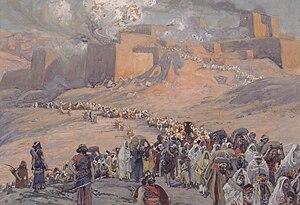
Back Babylonisches Exil ALS السبي البابلي Arabic السبى البابلى ARZ Babil sürgünü Azerbaijani Вавілонскі палон Byelorussian Вавилонски плен Bulgarian ব্যাবিলনীয় বন্দিদশা Bengali/Bangla Harlu Babilon Breton Captiveri babiloni Catalan Babylonské zajetí Czech
This article needs additional citations for verification. (May 2024) |

The Babylonian captivity or Babylonian exile is the period in Jewish history during which a large number of Judeans from the ancient Kingdom of Judah were forcibly relocated to Babylonia by the Neo-Babylonian Empire.[1] The deportations occurred in multiple waves: After the siege of Jerusalem in 597 BCE, around 7,000 individuals were deported to Mesopotamia. Further deportations followed the destruction of Jerusalem and Solomon's Temple in 587 BCE.[1]
In the biblical account, after the Battle of Carchemish in 605 BCE, the Babylonian king Nebuchadnezzar II besieged Jerusalem, which resulted in tribute being paid by the Judean king Jehoiakim.[2] In the fourth year of Nebuchadnezzar II's reign, Jehoiakim refused to pay further tribute, which led to another siege of the city in Nebuchadnezzar II's seventh year (598/597 BCE) that culminated in the death of Jehoiakim and the exile to Babylonia of his successor Jeconiah, his court, and many others; Jeconiah's successor Zedekiah and others were exiled when Nebuchadnezzar II destroyed Jerusalem in his 18th year (587 BCE), and a later deportation occurred in Nebuchadnezzar II's 23rd year (582 BCE). However, the dates, numbers of deportations, and numbers of deportees vary in the several biblical accounts.[3][4]
The Bible recounts how after the fall of the Neo-Babylonian Empire to the Achaemenid Empire at the Battle of Opis in 539 BCE, exiled Judeans were permitted by the Persians to return to Judah.[5][6] According to the biblical Book of Ezra, construction of the Second Temple in Jerusalem began c. 537 BCE in the new Persian province of Yehud Medinata. All of these events are considered significant to the developed history and culture of the Jewish people, and ultimately had a far-reaching impact on the development of Judaism.[1]
Archaeological studies have revealed that, although the city of Jerusalem was utterly destroyed, other parts of Judah continued to be inhabited during the period of the exile. Historical records from Mesopotamia and Jewish sources indicate that a significant portion of the Jewish population chose to remain in Mesopotamia. This decision led to the establishment of a sizable Jewish community in Mesopotamia known as the golah (dispersal), which persisted until modern times.[1] The Iraqi Jewish, Persian Jewish, Georgian Jewish, Bukharan Jewish, and the Mountain Jewish communities are believed to derive their ancestry in large part from these exiles; these communities have now largely immigrated to Israel.[7][8]
- ^ a b c d Lemche, Niels Peter (2004). Historical dictionary of ancient Israel. Historical dictionaries of ancient civilizations and historical eras. Lanham, Md.: Scarecrow Press. p. 73. ISBN 978-0-8108-4848-1.
- ^ Coogan, Michael (2009). A Brief Introduction to the Old Testament. Oxford: Oxford University Press.
- ^ Moore, Megan Bishop; Kelle, Brad E. (2011). Biblical History and Israel S Past: The Changing Study of the Bible and History. Wm. B. Eerdmans Publishing. pp. 357–58. ISBN 978-0802862600. Retrieved 11 June 2015.
Overall, the difficulty in calculation arises because the biblical texts provide varying numbers for the different deportations. The HB/OT's conflicting figures for the dates, number and victims of the Babylonian deportations become even more of a problem for historical reconstruction because, other than the brief reference to the first capture of Jerusalem (597) in the Babylonian Chronicle, historians have only the biblical sources with which to work.
- ^ Dunn, James G.; Rogerston, John William (2003). Eerdmans Commentary on the Bible. Wm. B. Eerdmans Publishing. p. 545. ISBN 978-0-8028-3711-0.
- ^ Jonathan Stökl, Caroline Waerzegger (2015). Exile and Return: The Babylonian Context. Walter de Gruyter GmbH & Co. pp. 7–11, 30, 226.
- ^ Encyclopaedia Judaica. Vol. 3 (2nd ed.). p. 27.
- ^ The Wellspring of Georgian Historiography: The Early Medieval Historical Chronicle The Conversion of Katli and The Life of St. Nino, Constantine B. Lerner, England: Bennett and Bloom, London, 2004, p. 60
- ^ Dekel, Mikhal (19 October 2019). "When Iran Welcomed Jewish Refugees".
© MMXXIII Rich X Search. We shall prevail. All rights reserved. Rich X Search